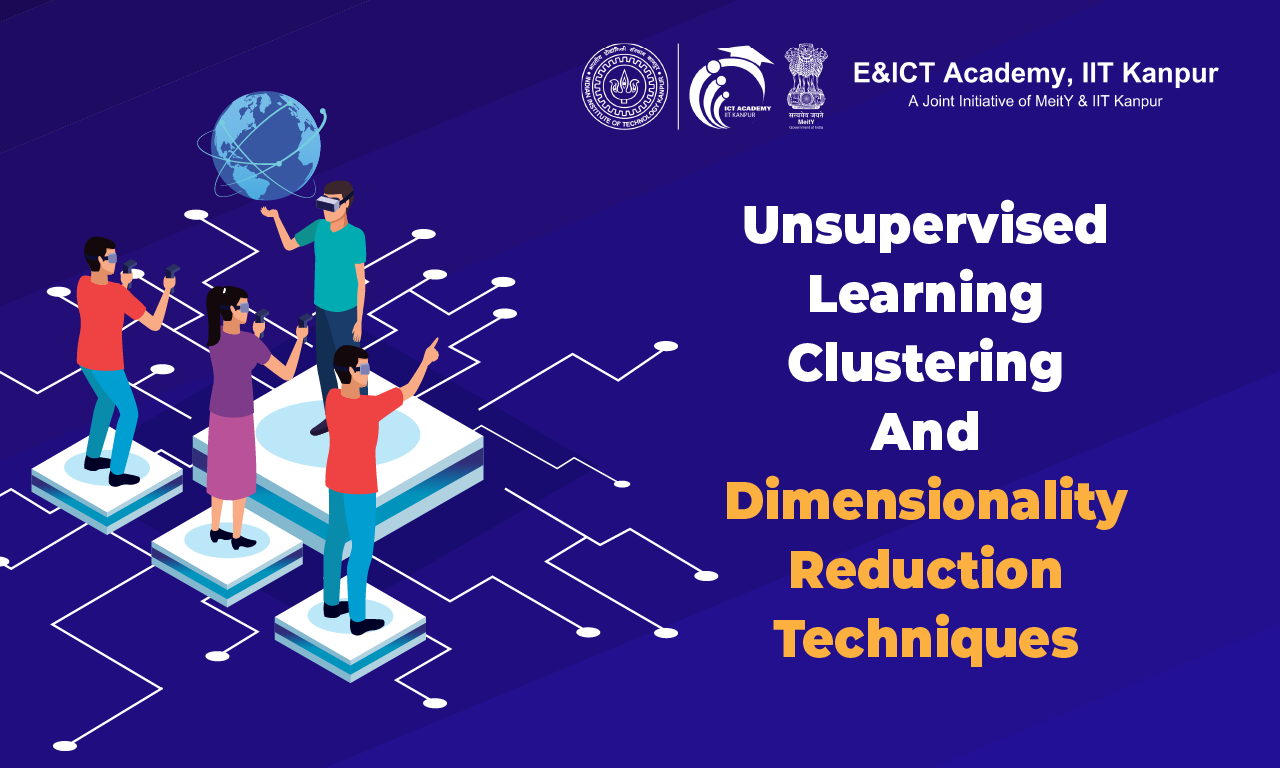Unsupervised Learning: Clustering And Dimensionality Reduction Techniques

Artificial Intelligence (AI) has recently been trending with the introduction of chatbots, since now, a subset of the facility is available to all. However, AI has been developing and making strides since long.
The global AI market size is estimated to reach $1,811.8 billion by 2030, growing at a compound annual growth rate or CAGR of 37.3%. It is also expected to contribute $15.7 trillion to the global economy by 2030. Professionals with a machine learning certification are likely to be in high demand as the market grows.
One of the largest contributors to the growth and market share of AI is Machine Learning (ML). It helps AI tools by enabling self-learning, improving performance from experience, and making predictions.
Growing at a CAGR of 38.8%, the market size of machine learning is expected to reach $225.91 by 2030. ML is developed on algorithms designed to process large amounts of data.
These algorithms fall under four categories: supervised learning, unsupervised learning, semi-supervised learning, and reinforcement learning. While each method has its advantages and disadvantages, unsupervised learning algorithms are where the machines do the complete work.
Unsupervised Machine Learning
When using unsupervised machine learning, AI technology does all the work. Unlike supervised learning, you do not have to label each data before feeding it to the machine for grouping and analysis.
Instead, the machine uses algorithms to find differences, similarities, or patterns in the data and classifies them accordingly without supervision. While the output may not be very accurate, unsupervised learning is the best method to process complex, unlabelled data, which can be easily retrieved from a computer.
This ML type is primarily used in network analysis, anomaly detection, and singular value decomposition. Unsupervised machine learning has two major approaches: Clustering and Dimensionality Reduction, which are discussed below.
Clustering Techniques
Clustering refers to grouping unlabeled data based on similarities or differences. Finding patterns in raw data and classifying them accordingly through clustering algorithms is easier.
This data mining technique can be categorized into the following types:
- Partitioning Clustering
Also known as hard clustering, where a data point can only belong to one group, partitioning clustering divides data into non-hierarchical groups. The k-means clustering algorithm is the most common form of this centroid-based method.
In K-means clustering, the dataset is divided into a pre-defined number of groups represented by K. The data are grouped according to their distance from the cluster center.
If the data has a large K value, the data has a smaller grouping. On the other hand, a smaller K value depicts a more extensive, less granular grouping.
- Hierarhial Clustering
Hierarchical cluster analysis divides the data set into a dendrogram, having different levels. This soft clustering enables multiple grouping of data. Hierarchical clustering can either be agglomerative or divisive.
In agglomerative clustering, the data sets are first divided into small groups, then merged on higher levels based on the similarity as a cluster. This can be done through various methods, including Ward’s, average, complete, or single linkage.
On the other hand, in divisive clustering, the data set is initially considered as one cluster, which is further divided into smaller groups in progressing levels based on the differences between the data points.
- Probabilistic Clustering
Probabilistic clustering or distribution model-based clustering divides data based on their probability of belonging to a particular distribution. The Gaussian Mixture Model (GMM) is the most common algorithm for probabilistic clustering.
GMM uses an unspecified number of distribution functions and divides data based on the probability of a data set. The variable for the clustering is assumed. Therefore, the expectation-maximization algorithm is commonly used with GMM.
- Density Based Clustering
The density-based clustering is a simple approach that divides data into groups based on their positioning. Highly dense areas are grouped as one cluster, forming arbitrary shapes.
Two clusters are divided by clear, sparser areas. However, this type of clustering is not helpful for data sets with varying densities.
- Fuzzy Clustering
Another type of soft clustering, the data sets are assigned membership coefficients, determining their degree of belonging to different clusters. The most common method used for this is the Fuzzy C-means algorith
Clustering techniques have wide applications in the real world. These include identifying cancer cells, customer segmentation, search engine results, market segmentation, anomaly detection, and statistical data analysis.
Dimensionality Reduction Techniques
The data dimension refers to the number of variables, columns, or inputs. Any dataset with multiple features can make prediction modeling difficult due to high dimensionality that causes overfitting and make it harder to visualize the data sets.
Dimensionality reduction is an essential aspect of machine learning since it helps drive more accurate results for large data sets by helping reduce the number of features under scrutiny, making the data more manageable without removing any integral part. This helps avoid the curse of dimensionality and produce a better-fit predictive model.
This helps improve data storage, reduce computation time, improve visualization, and remove redundancy in the data. Dimensionality reduction techniques either select existing features (Feature Selection) or combine existing features to extract a new feature for clustering (Feature Extraction).
Machine learning generally uses Feature Extraction for pre-processing the data. The most common techniques used are:
- Principal Component Analysis
For feature extraction, Principal Component Analysis (PCA) uses a linear transformation to produce a set of new principal components, reducing the number of dimensions to a minimum without information loss.
The process is repeated to find linear transformations which are entirely uncorrelated to each other in an orthogonal way. This helps maximize the variance of the data set.
- Singular Value Decomposition
Singular Value Decomposition (SVD) divides a principal matrix into three lower matrices. It is generally based on the formula A = USVT, where U and V represent orthogonal matrices, and S represents a diagonal matrix.
Like PCA, it is generally used to reduce noise and compress data, such as in image files.
- Random Forest
Another popular dimensionality reduction method in machine learning, the random forest technique, has an in-built algorithm for generating feature importance. It uses statistics of each attribute to find the subset of features.
However, this algorithm only accepts numerical variables. Therefore, the data has to be first processed using hot encoding.
Conclusion
Unsupervised machine learning is one of artificial intelligence’s fastest-growing and in-demand subsets. Its ability to process unlabeled data without any known output value allows it to see patterns humans cannot infer.
Aside from its role in developing AI, unsupervised machine learning has various real-world applications. These include better data management, hierarchical clustering, visualization of data, and any anomalies.
With its expanding areas, there is a demand for AI developers in the market. If you also want to jump on the wagon, consider online courses to learn from the best.



